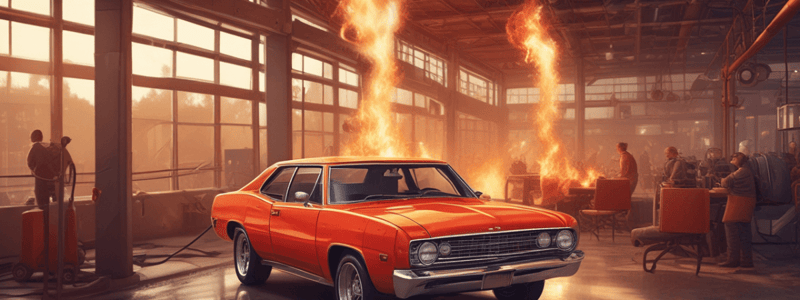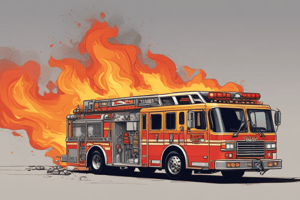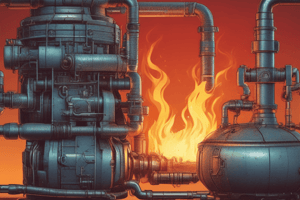Podcast
Questions and Answers
What is the primary characteristic of the incipient stage of a fire?
What is the primary characteristic of the incipient stage of a fire?
- The fire is small and confined to a small portion of the fuel. (correct)
- The fire is spreading to new fuel packages.
- The fire is consuming the maximum amount of oxygen.
- The fire has reached its peak heat release rate.
During the growth stage, what may happen to nearby fuels due to radiant heat from the fire?
During the growth stage, what may happen to nearby fuels due to radiant heat from the fire?
- They may become fully developed.
- They may reduce to smoldering fires.
- They may self-extinguish.
- They may begin to pyrolize. (correct)
What determines the peak heat release rate of a fire?
What determines the peak heat release rate of a fire?
- The amount of oxygen available. (correct)
- The amount of fuel available.
- The type of fuel involved.
- The size of the fuel package.
What happens to a fire when it enters the decay stage?
What happens to a fire when it enters the decay stage?
What type of fire may self-extinguish in the decay stage?
What type of fire may self-extinguish in the decay stage?
What happens if oxygen becomes available during the decay stage of a fire?
What happens if oxygen becomes available during the decay stage of a fire?
At what stage does the fire consume the maximum amount of oxygen?
At what stage does the fire consume the maximum amount of oxygen?
What is the result of the fire consuming the available fuel or oxygen?
What is the result of the fire consuming the available fuel or oxygen?
What determines the duration of the decay stage of a fire?
What determines the duration of the decay stage of a fire?
At what stage does the fire spread to new fuel packages?
At what stage does the fire spread to new fuel packages?
The ______ stage starts with ignition when the three elements of the fire triangle come together and the combustion process begins.
The ______ stage starts with ignition when the three elements of the fire triangle come together and the combustion process begins.
At the ______ stage, more of the initial fuel package becomes involved and the production of heat and smoke increases.
At the ______ stage, more of the initial fuel package becomes involved and the production of heat and smoke increases.
The ______ stage occurs when all combustible materials in the compartment are burning at their peak heat release rate based on the available oxygen.
The ______ stage occurs when all combustible materials in the compartment are burning at their peak heat release rate based on the available oxygen.
The fire enters the ______ stage as the fire consumes the available fuel or oxygen and the heat release rate begins to decline.
The fire enters the ______ stage as the fire consumes the available fuel or oxygen and the heat release rate begins to decline.
During the ______ stage, the fire may spread to new fuel packages.
During the ______ stage, the fire may spread to new fuel packages.
Radiant heat from the fire may begin to ______ nearby fuels.
Radiant heat from the fire may begin to ______ nearby fuels.
The fire is consuming the maximum amount of ______ that it can during the fully developed stage.
The fire is consuming the maximum amount of ______ that it can during the fully developed stage.
The ______ stage is the stage where the fire is small and confined to a small portion of the fuel first ignited.
The ______ stage is the stage where the fire is small and confined to a small portion of the fuel first ignited.
The fire may continue to grow to become ______ developed or may enter an early state of decay depending upon available oxygen.
The fire may continue to grow to become ______ developed or may enter an early state of decay depending upon available oxygen.
Fuel-limited fires may reduce to ______ fires during the decay stage.
Fuel-limited fires may reduce to ______ fires during the decay stage.
Flashcards are hidden until you start studying
Study Notes
Fire Development Stages
- Fire starts with ignition, when the three elements of the fire triangle come together, initiating the combustion process.
- Incipient stage is characterized by a small, confined fire in a small portion of the initial fuel.
- Growth stage begins when more of the initial fuel package becomes involved, leading to increased heat and smoke production.
- Radiant heat from the fire may pyrolyze nearby fuels, spreading the fire to new fuel packages.
- The fire may continue to grow or enter an early stage of decay, depending on available oxygen.
Fully Developed Stage
- Occurs when all combustible materials in the compartment burn at their peak heat release rate, based on available oxygen.
- The fire consumes the maximum amount of oxygen possible.
- If the fire is limited to one fuel package, the fully developed stage occurs when the entire fuel package is on fire and has reached its peak heat release rate.
Decay Stage
- Fire enters decay stage as it consumes available fuel or oxygen, and heat release rate declines.
- Fuel-limited fires may self-extinguish or reduce to smoldering fires.
- Ventilation-limited fires may also self-extinguish.
- If oxygen becomes available during decay stage, fires may reenter the growth stage and rapidly become fully developed.
Fire Stages
- The fire starts at the incipient stage, where the three elements of the fire triangle come together, igniting a small, confined portion of the fuel.
- At this stage, the fire is small and produces minimal heat and smoke.
Growth Stage
- The fire transitions to the growth stage, involving more of the initial fuel package, increasing heat and smoke production.
- Radiant heat from the fire can pyrolize nearby fuels, spreading the fire to new fuel packages.
- The fire may continue to grow into a fully developed stage or enter an early state of decay, depending on available oxygen.
Fully Developed Stage
- The fully developed stage occurs when all combustible materials in the compartment are burning at their peak heat release rate, based on available oxygen.
- The fire consumes the maximum amount of oxygen available.
- If the fire is limited to one fuel package, the fully developed stage occurs when the entire fuel package is on fire and reaches its peak heat release rate.
Decay Stage
- The fire enters the decay stage as it consumes available fuel or oxygen, and the heat release rate begins to decline.
- Fuel-limited fires may self-extinguish or reduce to smoldering fires during this phase.
- Ventilation-limited fires may also self-extinguish.
- If oxygen becomes available during the decay stage, the fire may reenter the growth stage and rapidly become fully developed.
Studying That Suits You
Use AI to generate personalized quizzes and flashcards to suit your learning preferences.




